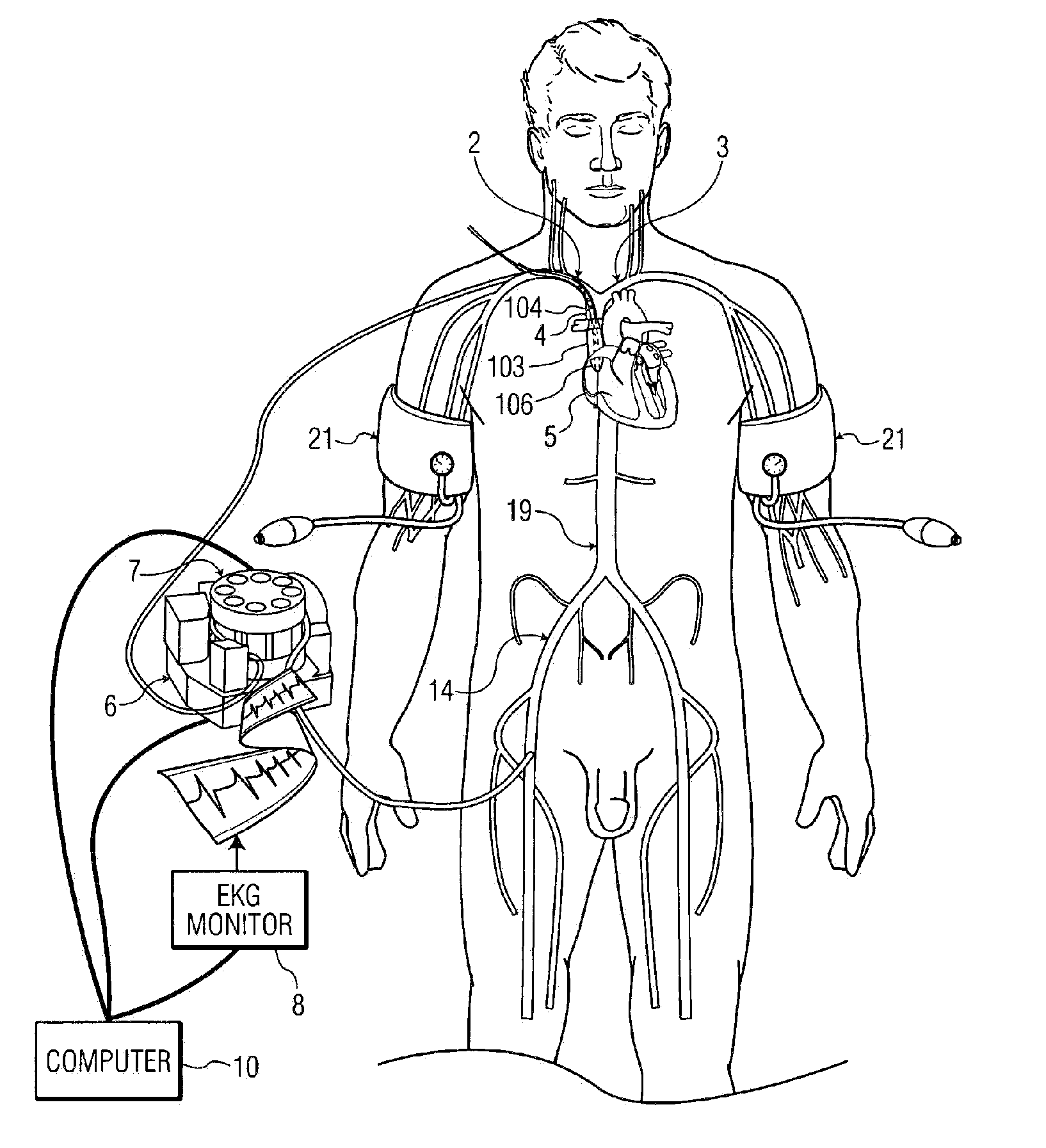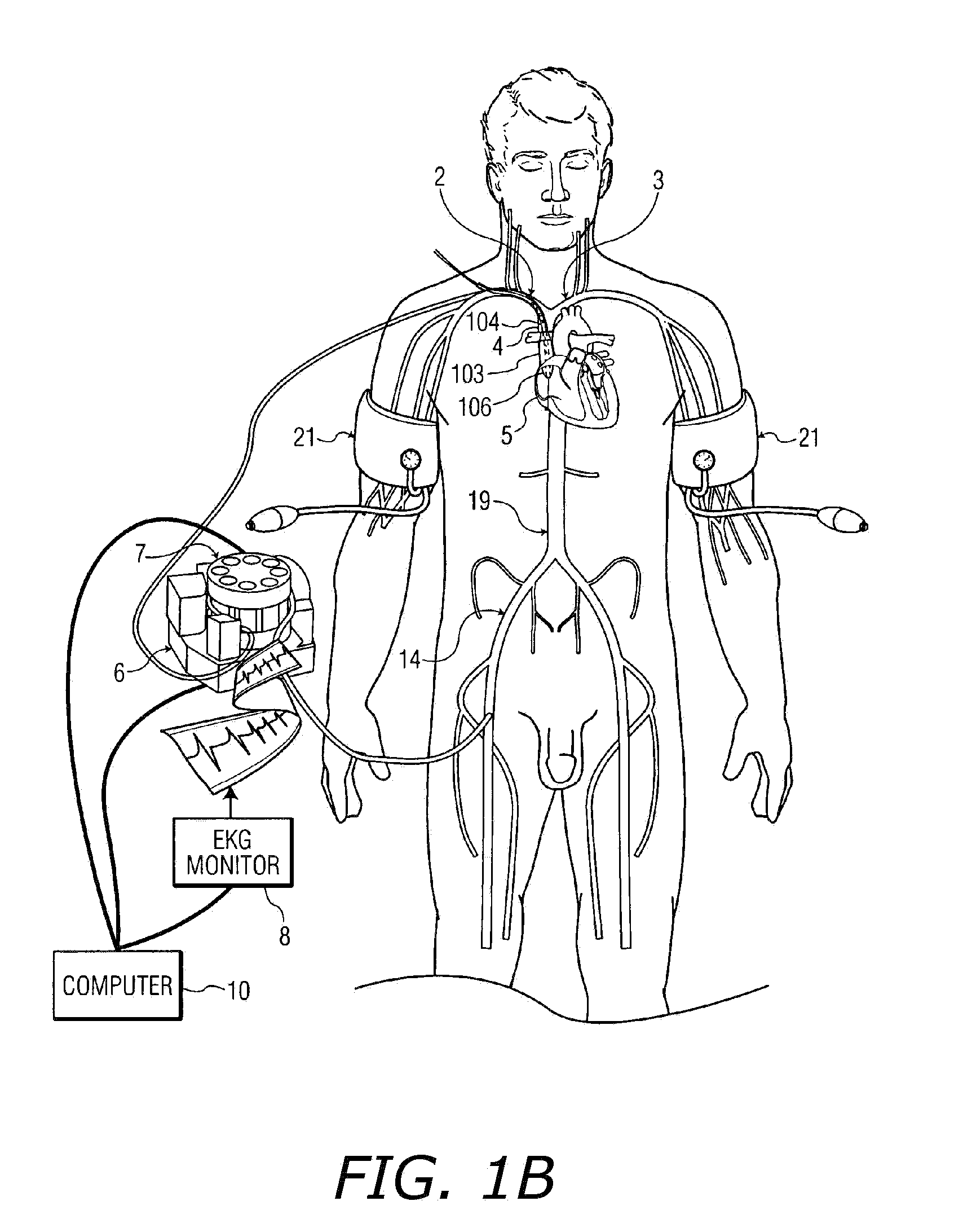System, Methods and Apparatus for Cerebral Protection
a technology of cerebral protection and system, applied in the field of medical devices, can solve the problems of reduced oxygen and nutrients to tissues, reduced cerebral perfusion, and neurological deficit of patients experiencing cerebral ischemia, so as to reduce the risk of ischemic damage, inhibit or minimize tissue damage, and maintain and/or improve cerebral perfusion.
- Summary
- Abstract
- Description
- Claims
- Application Information
AI Technical Summary
Benefits of technology
Problems solved by technology
Method used
Image
Examples
first embodiment
III. First Embodiment
[0083]The present embodiment describes a method and system for selectively perfusing the brain with retrograde cold blood during acute cessation of perfusion to a specific area of the brain due to closure or lack of flow in the arterial blood supply to that segment. It is noted that in the embodiments described throughout the specification, the various methods may utilize the left subclavian vein or the right subclavian vein with equal efficacy of operation.
[0084]FIG. 1B shows a zoom view of the thoracic region of FIG. 1A showing in detail the region of insertion of the elongate catheter 104.
[0085]Referring to FIG. 1B, elongate catheter 104 is shown, for proper placement, advanced into the right atrium 5. Upon correct positioning, for example using the guide wire 13, the tip 106 of the elongate catheter 104 is placed at very close proximity to the right atrial-superior vena cava junction 12. The inflatable occlusion balloon 103 is positioned in the superior vena...
second embodiment
IV. Second Embodiment
[0095]With reference now to FIGS. 2A and 2B of the drawings, there is illustrated a method and system, according to another embodiment for selectively perfusing the brain with retrograde cold blood during acute cessation of perfusion to a specific area of the brain due to closure or lack of flow in the arterial blood supply to that segment.
[0096]As illustrated thus far in the previous exemplary embodiment (as shown in FIGS. 1A and 1B), the balloon-tipped catheter 104 includes a single balloon 103. In the present exemplary embodiment (as shown in FIGS. 2A and 2B), an alternative balloon-tipped catheter arrangement is used which includes a pair of balloons 103 and 107. Otherwise, the present embodiment is similar to the previous embodiment in most respects.
[0097]In accordance with the present exemplary embodiment illustrated in FIGS. 2A and 2B, the additional short self-inflation balloon 107 is used to occlude the subclavian vein 2 internally. It is noted that the...
third embodiment
VI. Third Embodiment
Femoral Catheter
[0101]With reference now to FIG. 4 of the drawings, there is illustrated a method and system, according to another embodiment, for selectively perfusing the brain with retrograde cold blood during acute cessation of perfusion to a specific area of the brain due to closure or lack of flow in the arterial blood supply to that segment.
[0102]The present embodiment is similar to the previously described embodiments in most respects. However, it is distinguishable from the previously described embodiments in that in the present embodiment, the catheter 104′ is significantly longer than the subclavian catheters 104, 204 previously described which in inserted in the subclavian vein 2. The catheter 104′, also referred to herein as the femoral catheter 104′, is longer than the subclavian catheter 104 to allow for insertion through either right or left femoral vein 15 instead of the right (or left) subclavian vein 2 as described above. The elongated balloon ...
PUM
 Login to View More
Login to View More Abstract
Description
Claims
Application Information
 Login to View More
Login to View More - R&D
- Intellectual Property
- Life Sciences
- Materials
- Tech Scout
- Unparalleled Data Quality
- Higher Quality Content
- 60% Fewer Hallucinations
Browse by: Latest US Patents, China's latest patents, Technical Efficacy Thesaurus, Application Domain, Technology Topic, Popular Technical Reports.
© 2025 PatSnap. All rights reserved.Legal|Privacy policy|Modern Slavery Act Transparency Statement|Sitemap|About US| Contact US: help@patsnap.com



